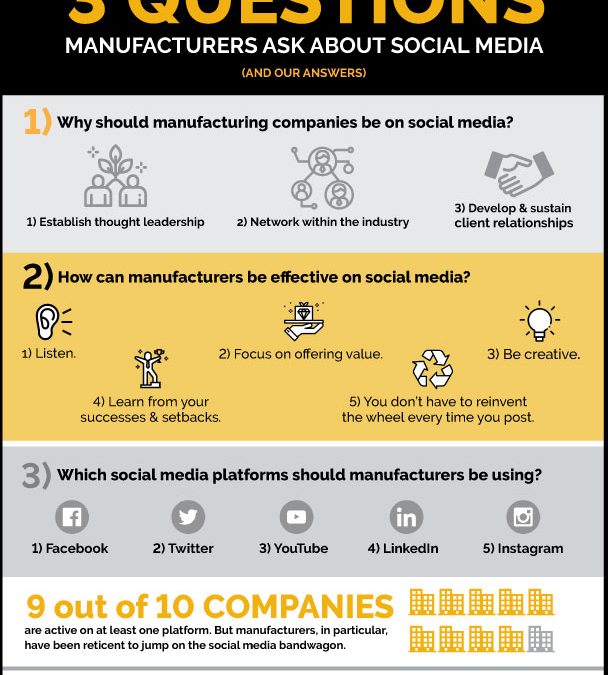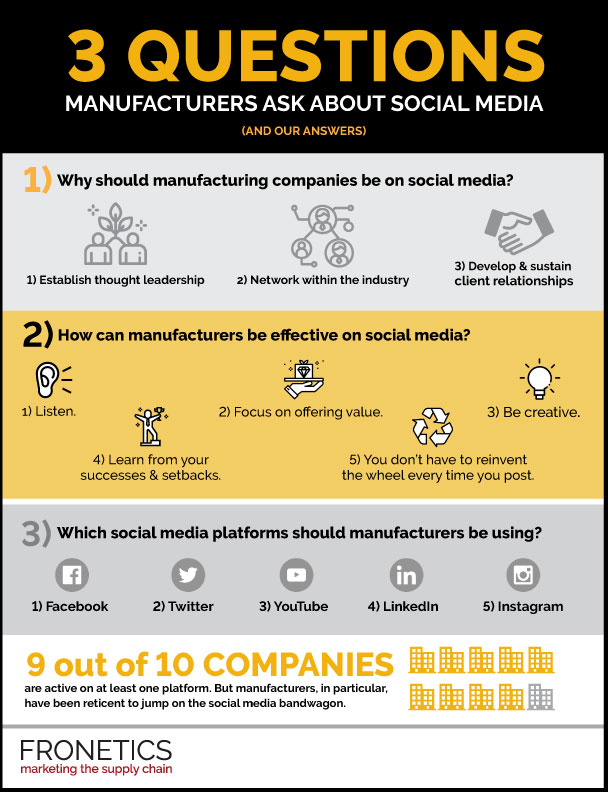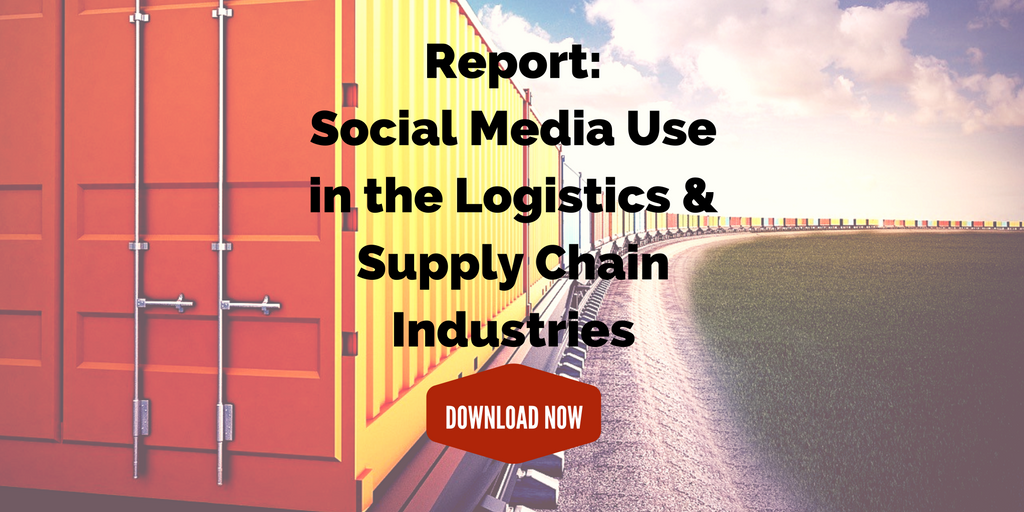
by Fronetics | May 1, 2019 | Blog, Content Marketing, Logistics, Manufacturing & Distribution, Marketing, Social Media, Supply Chain
We get many queries from manufacturers about social marketing — mostly, why and how should I use it — so here are our answers to the most-popular questions manufacturers ask about social media.
Highlights:
- Facilitate networking opportunities, thought leadership, and prospect/client relationships.
- Consider using popular platforms like YouTube and Instagram to engage users and drive website traffic.
- Don’t use social media to push your products.

(Made with Canva)
B2B operations have increasingly embraced social media as a strategic marketing tool. In fact, 9 out of 10 companies are active on at least one platform. But manufacturers, in particular, have been reticent to jump on the social media bandwagon.
If your manufacturing operation isn’t making use of social media as a tool to engage with your audience, you’re missing out on big lead generation potential. Manufacturers like the Dow Chemical Company, ArcelorMittal, and CAT Products are among those that have figured out how to harness the power of social media.
To help you launch or refine your efforts, we’ve put together the following answers to the most-popular questions manufacturers ask about social media.
Why should manufacturing companies be on social media?
There are three major reasons that manufacturing brands should be all over social media:
- Establish thought leadership
- Network within the industry
- Develop and sustain client relationships
Notice that none of these involve selling products. As with content marketing in general, good social media marketing isn’t about pushing your products.
To make the most of social media as a marketing tool, abandon the idea that it’s about blatant sales pitches. Instead, approach it from the perspective that it’s an inherently social tool – that is, its value for manufacturers is in its potential to establish and expand thought leadership and to cultivate meaningful and fruitful relationships within your industry and among prospects and clients.
Which social media platforms should manufacturers be using?
Not all social media platforms are created equal. Each requires its own strategy, content format, and media. We recommend that manufacturers consider these five platforms:
1) Facebook
Facebook is an excellent place to share content with a wide segment of your audience, to promote engagement (through likes, comments, and shares), and to engage with peers and prospects. Not only that, the savviest marketers are using Facebook to understand their industry better – everything from strategies of peer brands to a fuller picture of your target buyer persona to the informational or product needs of your prospects.
2) Twitter
Twitter’s format is about brief, pithy content, used to engage with and inform your audience. This is an ideal place to let customers know what you’re planning next, to establish your corporate personality, and to let your audience in on a slice of your day-to-day operations and values.
3) YouTube
Video marketing for manufacturers is skyrocketing. With video being the most popular form of content online today, YouTube is an obvious choice for marketers. Whether it’s “how to” videos, footage of your operations, or interviews with subject-matter experts, your brand should be using YouTube to drive search traffic and educate prospects.
4) LinkedIn
B2B marketers unequivocally rank LinkedIn as the most effective network for lead generation, follower engagement, and traffic to their websites. An ideal place to engage with industry leaders, LinkedIn is also great for distributing content to a focused audience.
5) Instagram
The popularity of this highly visual platform has continued to skyrocket – it’s currently the second-most-used social media platform (up from fourth just two years ago). And believe it or not, this picture-based network is a powerhouse for B2B brands. We’ve written extensively about how brands can leverage Instagram and Instagram Stories. Suffice it to say, this is a perfect place to post your most engaging visual content and actively engage with followers.
How can manufacturers be effective on social media?
As with any content marketing effort, a well-thought-out social media strategy is a big part of success. As you create and begin to implement your strategy, start with these five tips.
1) Listen.
Before you post even a single piece of content, start by listening to your audience. In the days before social media, marketers had it much harder when it came to determining audience needs and preferences. Use these platforms to research your target prospects, as well as how competitors are engaging followers. Make note of the questions your target audience has, frustrations or challenges they express, and what types of content they engage with.
2) Focus on offering value.
You’d be surprised how many manufacturers neglect to place a premium on simply being useful with their social media content. It’s not complicated: If you post relevant, valuable content for your target audience, you’ll boost engagement, grow brand awareness, and generate and convert more leads.
3) You don’t have to reinvent the wheel every time you post.
One of the great things about social media is that it rewards not only content creation, but content curation. While you do want to be posting original content most of the time (experts recommend about 60%), a good chunk of your posting activity should include curating relevant content from third parties to share with your followers.
4) Be creative.
Separating yourself from your competitors can be a challenge, but it’s one worth striving toward. Start by asking yourself what makes your operation unique, what’s special about your process, what industry-leading expertise does your executive team have, what unusual perspective can you offer? Next, start breaking these four rules.
5) Learn from your successes and setbacks.
There are many tools out there to help you track the results of your social media efforts. Determine the right KPIs for your business and keep track of your results relentlessly. These metrics will allow you to study your impact and frequently tailor your strategy accordingly.
It’s time for manufacturers to fully embrace the marketing potential of social media. Whether you create and implement your own strategy, or decide to outsource your social media efforts, social media is a powerful set of tools that manufacturers should be harnessing.
Are there other questions manufactures ask about social media that we missed? Let me know in the comments.
Related posts:


by Fronetics | Apr 30, 2019 | Blog, Current Events, Marketing, Social Media, Video Marketing
Also, this month in social media news: LinkedIn adds a “Teammates” option to facilitate connections among colleagues, and Facebook is testing a Stories-like newsfeed.
Highlights:
- Facebook is giving users increased access to what information advertisers have on them.
- Instagram is considering joining Facebook in promoting communal video experiences.
- LinkedIn’s “Teammates” feature helps users prioritize content from close connections.
This month in social media news, Facebook is continuing to combat user privacy concerns by introducing a tool to provide greater transparency about the content they see on their Newsfeeds, both from connections and from advertisers. The platform is also continuing to explore the Stories trend, as it conducts early-stage testing of a layout that resembles the Stories feature more than it does the existing Newsfeed.
Both Instagram and LinkedIn are promoting greater community among users. Instagram is testing a group video viewing option, joining Facebook’s Watch Party, introduced last year. LinkedIn is rolling out a feature which allows users to prioritize content from their closest connections. Read on for a round-up of social media news.
Facebook Introduces a Feature to Assist Users in Understanding the Context of Content Appearing on the Newsfeed
Having been embroiled in ongoing privacy-related scandals, Facebookis making users’ safety and comfort using the platform a priority. To that end, the company has announced that it will be giving users greater control over the content that appears on their Newsfeeds, through the “Why am I seeing this post?” feature.
In 2014, the social media giant launched its similar feature, “Why am I seeing this ad?” which was geared toward projecting transparency in the company’s embattled relationship with users and their advertising content. Facebook announced simultaneously that it will be “making improvements” to the older feature. The new “Why am I seeing this post?” feature aims to help users understand the context for what shows up in their Newsfeeds, and it also allows them to control and manage content.
Marketers should be aware that users will now be able to find out when their profile information matches with the information on an advertiser’s list, as well as when an advertiser “saves their personal information in their database and other details such as if they (the users) were targeted by the advertiser through another marketing partner of theirs (advertisers).”
Instagram Tests a Communal Video Viewing Option
Social media platforms are continuing to push the boundaries of social experiences that are possible for users not in physical proximity. Back in 2018, Facebook rolled out its “Watch Party” option, and now Instagram is exploring jumping on the bandwagon, testing a similar function in its app.
The feature would allow users to view video content on Instagram with a friend, while simultaneously seeing their reactions on screen, using the phone’s camera, in a split-screen view. Users can also apply face filters and other visual tools to the personal feed. Instagram and Facebook’s features are part of a larger trend toward “multi-participatory consumption.”
LinkedIn Adds a New “Teammates” Option to Maintain Connections Among Colleagues
In an ongoing attempt to boost on-platform engagement, LinkedIn has introduced a new feature called “Teammates.” It enables users to put a priority on updates from immediate connections, content with which LinkedIn has found that its users are 60% more likely to engage than more distant connections. As users place a priority on updates from teammates, it will appear higher in their feeds.
The network is pushing the feature as promoting community within the workplace: “95% of working professionals think it’s a good idea to have friends at work, and 63% say they have relationships with their co-workers outside the office. Based on a recent study we shared last month, having friends at work can also help you advance your career.”
Marketers should take note, since it’s not immediately clear what the impact of this feature will be on branded content. Nonetheless, it emphasizes the value of cultivating meaningful connections on the platform, as potential clients will be more likely to mark these types of connections as “teammates,” placing a higher priority on their content.
Facebook is Testing a Stories-Like Swipeable Newsfeed
Stories features across the social media landscape continue to grow in popularity. In keeping with the trend, Facebook is experimenting with a Newsfeed layout which allows users to side-scroll or swipe between posts in their feed, rather than scrolling down. This is a potential significant re-design for the platform, and points to the fact that the Stories trend is here to stay.
If Facebook adopts the design, it would merge Stories and Newsfeed content into a single stream. The network emphasized to TechCrunchthat it is “in the very early stages of development,” and “still needs to conduct a lot more user research before any public experimentation can take place.”
Therefore, while it’s unlikely that a new Newsfeed is coming soon, what is clear is that social media platforms are experimenting with increasingly integrating Stories-style content into every aspect of the user experience.
Related posts:


by Fronetics | Apr 24, 2019 | Blog, Content Marketing, Marketing, Marketing Automation
Artificial intelligence is reshaping the way we live and do business. But can robots replace humans when it comes to content creation?
Highlights
- Artificial intelligence is already creating content.
- Some analysts predict that human writers will become obsolete in time.
- At least for now, there are aspects of human-generated content that robots can’t replicate.
What used to be a light-hearted, science-fiction version of the future — in which menial jobs would increasingly be performed by robots — has increasingly become a reality. We’ve seen how automation has shaped the supply chain and logistics industries in the past decade. But as artificial intelligence (AI) continues to evolve and reach new levels of sophistication, will something as complex as content creation no longer require human input?
AI is already creating content
In 2016, McKinsey Quarterly predicted that “while automation will eliminate very few occupations entirely in the next decade, it will affect portions of almost all jobs to a greater or lesser degree, depending on the type of work they entail.” Of course, there are jobs that require empathic functions or advanced social skills, which are less subject to replacement by machine learning. But content creation, though it does require original thought and synthesis of complex ideas, is in a greyer area.
The fact is, AI-generated content is already a reality. It shouldn’t come entirely as a surprise. After all, we’ve been writing about marketing automation for a while now, including, for example, chatbots or computer programs that simulate human conversation. According to Joe Pulizzi, founder of the Content Marketing Institute, “In 10 years, the majority of content will be generated by software. In 20 years, humans will wonder why we wasted so much time on content creation.”
In a notable example of AI creating content, the Washington Post developed “Heliograf,” a bot capable of generating short reports for readers, to aid in the coverage of the 2016 Olympic Games in Rio. When it was first developed, Heliograf could update readers on game outcomes, including when medals were awarded. Since then, it has written over 850 articles, including updates on high school football games and automated earnings coverage. Even now, the Washington Post uses Heliograf to supplement the work of its human writers — and has no intention of replacing them.
Natural language generation
Before we get further into the nitty-gritty of whether human content writers are doomed to obsolescence, let’s take a step back and take a look at the main function of AI when it comes to content creation. Natural language generation (NLG) is how we describe AI that can produce logical, coherent text.
“Natural language generation is a software process that automatically turns data into human-friendly prose,” writes Laura Pressman of Automated Insights. It’s important to recognize that while NLG can create content, it can’t do so without being fed data and a templated format. Essentially, when given data and a format, NLG can output content that reads as if it was written by a human.
Why we still need humans
It’s staggering what AI can produce when it comes to convincing, effective content. But even as technology becomes smarter and more sophisticated at creating content, humans haven’t been replaced just yet.
Proponents of fully AI-driven marketing argue that the kind of creativity required to produce effective content marketing can all be boiled down to numbers. While it’s true that content marketing should be data-driven, studies are also increasingly showing the value of intangible creativity — the kind that can’t be generated by an algorithm — in the marketing sector and beyond.
The memories, emotions, preferences, and frailties of human writers allow for the possibility of creativity and connection that AI can’t replicate. Yes, content marketing is about data. But there’s no substitute for the way a human brain can create language and ideas that connect and resonate with another human brain.
Related posts:


by Fronetics | Apr 23, 2019 | Blog, Content Marketing, Marketing
As the purchasing landscape increasingly skews younger, you need to think about how to improve your visual content to satisfy buyers’ preferences.
Highlights:
- Audiences increasingly prefer visual content.
- Optimize visual content for search engines by including text.
- Use graphics to make data pop.
Digital natives, who make up the majority of today’s B2B purchasing landscape, are highly steeped in online content. And, it may come as no surprise, they overwhelmingly prefer visual presentation, whether in video, infographic, animation, or gif format. What does this mean? Supply chain marketers need to adapt or be left behind.
While this doesn’t mean that text-based marketing is a thing of the past, it does mean that all your branded content — from blog posts to infographics to case studies to video — needs to be design-minded and visually appealing. These five suggestions will help improve your visual content game.
5 ways to improve your visual content
1) Optimize for search engines.
The biggest downside to visual content such as videos and infographics is that they aren’t searchable in the way that text-based content is. But this doesn’t mean that you need to lose out on the SEO benefits when publishing this type of content.
First off, it pays to post a text transcript with video or accompanying explanatory text with infographics and images. It’s also important for you to categorize and organize your visual content, which means labeling visual assets like logos and images with relevant keywords. When publishing them, be sure to tag images with keywords.
2) Make data interesting.
Common sense tells us that reading a bunch of numbers is far less compelling than seeing numerical data presented graphically. B2B marketers are in a prime position to make use of attractive data presentation, such as charts, graphs, animated images, or other formats to display your numerical data.
3) Create reusable graphics.
If you’re investing in visual content creation, it pays to consider how it can be reused. For example, when creating an infographic, consider how you can break it up into multiple graphics, each containing a set of statistics or other information. This way, you can add these smaller graphics to other pieces of text content, boosting engagement and adding visual appeal.
Additionally, keep in mind that visual snippets are ideal for posting on social media, as teasers, or even self-contained Instagram or Facebook Stories.
4) Keep your branding consistent.
A key point with visual content creation is consistent branding. Your brand’s visual presentation includes fonts, colors, font sizes, image styles, and anything else that is a visual indicator of your identity.
The first step to consistent branding is to document visual guidelines clearly and to distribute them to all content creators, along with samples for their use. Each time you publish visual content, make checking against the guidelines part of your editorial process.
5) Use visual content to tell a story.
Good content marketing is all about presenting information in a story format. Great content marketing also packs emotional resonance. When creating visual content, start with the idea of telling a story. Ideally, you’re presenting data in a way that communicates a feeling and elicits an emotional response from the viewer. If your data is impactful, your viewers will forge an emotional connection with your brand.
How are you trying to improve your visual content?
Related posts:


by Fronetics | Apr 18, 2019 | Blog, Current Events, Manufacturing & Distribution, Robotics & Automation, Supply Chain
A McKinsey & Company report studied the impact of automation in manufacturing driven by rapid advances in robotics, AI, and machine learning.
Highlights:
- New robotics technologies are cheaper, faster, and smarter than before.
- 87% of hours workers spend in production could be automated with existing technologies.
- Learn what four factors to consider when making decisions about automation.
Since the industrial revolution, automation has been a major disruptor in manufacturing. Once again, a new generation of robotics and related technologies is reshaping the face of the manufacturing and distribution industries. In fact, American manufacturing has made a recent comeback, thanks in large part to the widespread use of automation and robotics.
Automation technologies that were once cost-prohibitive are now more achievable — and the return on investment is greater than ever before. The new generation of robots are not only far less expensive than their ancestors, but they are also more versatile, flexible, and able to learn new tasks, even those that were far too difficult for machines just a few short years ago.
Robots are now capable of, for example, “picking and packing irregularly spaced objects, and resolving wiring conflicts in large-scale projects in, for example, the aerospace industry,” according to a recent report from McKinsey & Company. Not only that, artificial intelligence is leveling the playing field between human and machine, and “increasing the potential for automating work activities in many industries. In one recent test, for example, computers were able to read lips far more accurately than professionals.”
Quantifying the impact of automation on manufacturing
McKinsey’s study, which covered 46 countries and about 80% of the global workforce, determined that a tremendous amount of working hours could be eliminated or repurposed by automation with technology that is already here.
The study found that “87% of the hours spent on activities performed by workers in production occupations are automatable — the most of any manufacturing occupation.”
And it doesn’t stop there. “Even among other occupations in manufacturing (for example, engineering, maintenance, materials movement, management, and administration), however, there is still significant opportunity, with approximately 45 percent of these working hours automatable as well.”
The cost and logistics of automating
In general, the study found that automation allowed wages to increase globally and profits to grow. The authors emphasize the fact that in order to capture long-term value from automation, manufacturers’ best bet is to implement technologies in phases, capturing value at each phase, allowing for future investment.
Many complex factors come into play when it comes to meeting the challenges associated with automation, deciding what to automate, and when to implement technologies to best capture long-term value. Cost is just one element, albeit an important one.
McKinsey suggests considering the following four factors when making decisions about what to automate:
- Technical feasibility
- Cost associated with developing and deploying necessary hardware and software
- Cost of labor and resultant “supply-and-demand dynamics”
- Benefits beyond labor substitution, such as increased output and quality, and fewer errors
An American manufacturing renaissance
The Association for Advancing Automation has predicted that “American manufacturing’s embrace of robotics will ensure a new manufacturing renaissance in this country.” Already, we’re seeing a steady trickle of companies reversing outsourcing trends, as it’s becoming profitable again for manufacturing to take place in the United States, rather than relying on cheap labor abroad.
As more operations embrace automation — and as we continue to witness rapid advances in robotics, AI, and machine learning — American manufacturers won’t be the only ones to reap the benefits. Many experts are predicting that automation in manufacturing will create new, better paying jobs.
Optimists include our own CEO Frank Cavallaro, who recently wrote: “From what I see now … I still feel optimistic that AI and automation will create leaner, more efficient operations that will, in turn, create new (even if different) jobs. To me, it still looks like the ones winning from the increasing technological advances in the manufacturing industry are, in fact, we humans.”
Related posts:










